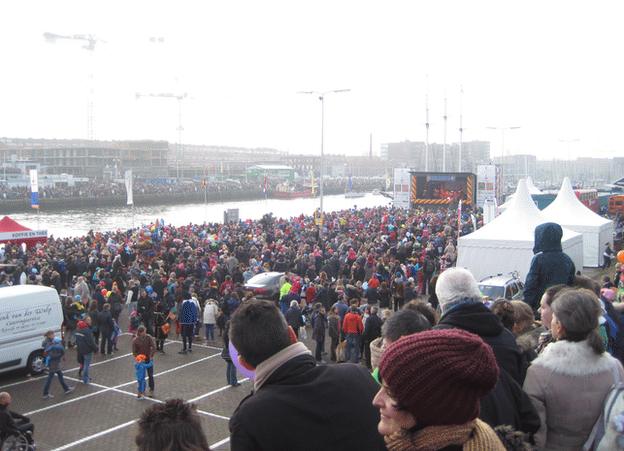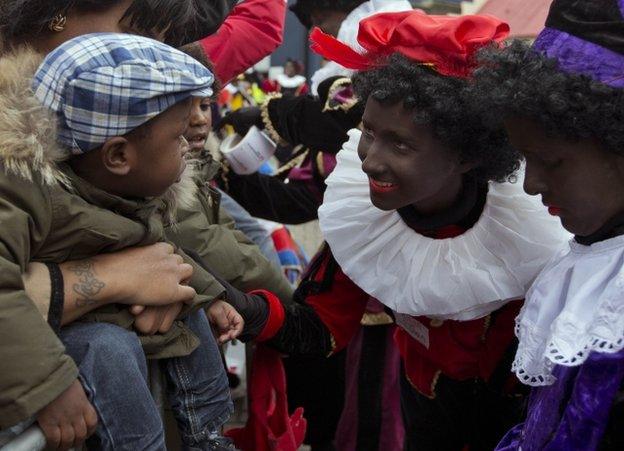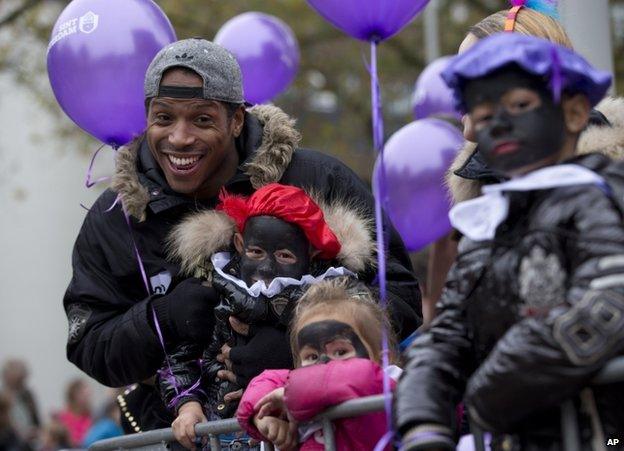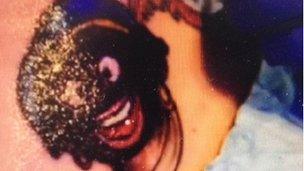Calling time on Black Pete fun in the Netherlands
- Published
What people in the Netherlands think about 'Black Pete'
It is one of the most popular Dutch traditions but according to a panel of UN experts, part of it is racist and should be abolished. The iconic figure of Black Pete has been arriving in towns and cities throughout the Netherlands. It is a curtain-raiser for the festive season and features a white person made up, wearing black face-paint and a curly Afro wig. Calls to ban it have caused outrage. Why is it so important in a country famous for promoting equality?
They are everywhere.
Riding bikes, launching themselves through hula hoops, somersaulting around the harbour and banging on drums. These controversial characters are integral to the celebrations.
This weekend represents "the arrival". When the ship docks, the Sinterklaas celebrations begin.
Clasping three children whose mouths are covered in chocolate, a blonde woman explains that it is gezelligheid.
There is no exact English translation, but the word can be best described as meaning a mixture of warm feeling and conviviality. It appears to encapsulate the atmosphere here.
Campaign
Not everyone in the Netherlands is excited by the annual appearance of Black Pete.

The Black Pete celebrations begin with the arrival of a ship

A big crowd turned out to see the ship.

Anti-racism demonstrators shunned the Black Pete parade in Amsterdam, turning their backs and taping their mouths.

Black Pete revellers deny they are racist. Here some revellers meet a family in Amsterdam.

Some black people were among the spectators at the Amsterdam event.
Caribbean poet Quinsy Gario was arrested in 2011 for staging a silent protest at a Sinterklaas parade. He has filed a complaint to the European Court of Human Rights, arguing that the Dutch state violated his basic right to freedom of expression.
He now leads campaigns to abolish Black Pete on the grounds that it perpetuates racist stereotypes.
As we are talking, on the corner of a main road in Rotterdam, two men stroll by shouting "Zwarte Piet".
We stop. I ask them to explain. They keep moving but as they go, they call back laughing, "He reminds us of Zwarte Piet."
It was a poignant illustration of the kind of discrimination Quinsy Gario says he and others face here.
The Netherlands is no longer a homogeneous nation.
After World War Two, canal-lined lowlands became a popular destination for economic migrants from Turkey and Morocco. A shared language also made it relatively easy for residents of the former Dutch Caribbean colonies to relocate.
In a country of approximately 17 million, more than 3.5 million are overseas-born Dutch citizens or children of non-Dutch immigrants.
Despite what it says on their passports, many of them are still referred to as allochtonen which literally translates as "originating from another country" or "outsiders".
Reaction
A panel of UN experts on minority rights intervened in the Sinterklaas celebrations after receiving a complaint from an anonymous group, concerned that Black Pete was a "living trace of past slavery and oppression" and that it "fostered an underlying sense of inferiority of African people in Dutch society".
The UN monitors warned the Dutch government that these factors combined may violate Black and Asian people's right to participate equally in the country they too call home.
The intervention electrified swathes of the Netherlands with indignation. Front-page newspaper spreads displayed cheerful profiles of ethnically mixed readers, supporting the annual practice of "blacking up".

One supporter, Michelle, has had Black Pete tattooed on her shoulder
A public Facebook petition - designed by a marketing company - has received more than 2m likes.
Inside a Rotterdam tattoo parlour, one artist explained, a perceived erosion of Dutch culture caused by immigration is responsible for the unusual outpouring of public discontent.
Cross-legged on a leather chair in front of us, Michelle has just had Black Pete's face inked between her shoulder blades.
"People have a right to express and preserve their own culture," she says. "As long as a culture is not violating human rights, then culture itself is a human right."
But a letter, external compiled by the UN rapporteurs of the working group on people of African descent and minority rights and sent to the Dutch government, warns that "sometimes practices, which are part of cultural heritage, may infringe upon human rights".
'Centuries of inferiority'
When questioned, almost every Dutch person will sincerely deny racist intent.
Rita Izsak is the UN's independent expert on minority issues and one of the co-authors of the letter submitted to the government. She smiles and offers a philosophical response: "Just because something is invisible to you, it doesn't mean it's not there."
Prime Minister Mark Rutte is being asked to ensure minority voices are heard amid the whirring majority.
And Rita Izsak encourages white people to do some research.
"Look at the pictures, read the history and you will understand why black people feel offended, it's really the hair which defines what it is to be black.
"They have suffered from inferiority for so many centuries and the last thing we should want, is to remind them of that past."
She ends our interview with an ultimate statement: "You don't mess with black hair."
Correction 25 November 2013: The text has been amended to make clear that the intervention has come from a panel of experts appointed to advise the UN, not the UN itself